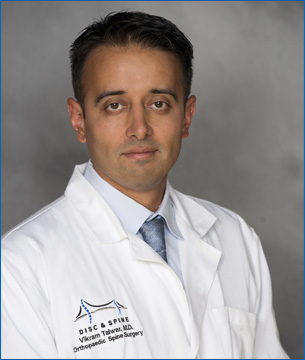Dr. Vikram Talwar

My education started off at Antioch High School where I realized that my strengths were in math, science and teaching. In fact as a senior in high school, I was also a teacher’s assistant for nursing mathematics at Los Medanos Community College. My other activities included swimming, waterpolo, and working in the kitchen of a local Chinese restaurant.
I went straight from high school into UC Berkeley. At Berkeley, I excelled in physics and organic chemistry, and tutored fellow students. My college research centered around high pressure physics in the geophysics realm. There I used diamond anvil cells to produce such high pressures that insulators would then turn into conductors. I also took classes within the practice of art, including drawing, sculpting, and advanced metal sculpture. For sports I swam and played club rugby. At this point I was working as a waiter and I taught Comedy Traffic School.
With a little break between college and med school, I worked at Bayer Parmaceuticals. There I worked on the production of recombinant Factor VIII (for hemophiliacs).Then I went off to medical school at Temple in Philadelphia. My research focus in med school was actually cardiology and understanding heart muscle changes in sheep. My third year of med school is when I started to assist in spine surgeries, in 1996. I was fascinated by its complexity. I learned how to examine patients, look at films, and the basic principles of surgery. During med school I played three years of rugby. We played up and down the Northeast against teams from other grad schools.
Surgical internship brought me back to the Bay Area. I worked at Highland and Kaiser Oakland in general surgery. The next year I worked at Kaiser Oakland with three spine surgeons, learning about the surgeries and the after-care of spine patients.
For the next four years I did a residency at San Francisco Orthopedic Residency Program. I went into my general ortho training, knowing I was going to be a spine surgeon. I did learn all the other orthopedic surgeries, but stayed focused on the spine. During these years I worked at Highland, St. Mary’s in San Francisco, Kaiser Oakland, Children’s in Oakland, and Shriner’s Hospital in Sacramento. The residency gave me opportunities to not only learn but to also teach other residents about anatomy, surgical approaches and patient care. Shriner’s Hospital introduced me to spine surgeons from UC Davis. I then went on to work with those same doctors at UC Davis in Sacramento for my fellowship in Spine Surgery. UC Davis Medical Center is a massive Level 1 trauma center for the Central Valley. I learned a lot about treating spine fractures (mainly non-operatively). I kept working with the Shriners to help children with scoliosis. Many patients I worked with had degenerative problems in the neck and low back. Also we operated on many patients that had tumors invading into their spines.Once I completed my education, I came back to the Bay Area where I have been practicing ever since. I love what I do. Seeing a patient, figuring out their problems, and making them better is what motivates me. The look on someone’s face, their emotions…when they get better…is priceless.
When a patient comes to see me, I want the whole experience to be positive. I sit down with each patient and take a careful history. Then I meticulously go over the x-rays, CAT scans, and MRIs with the patient so they can understand the films and their problems. I have even found aneurysms, tumors and cysts unrelated to the spine by paying attention to the “whole” image. I physically examine each patient, looking for nerve issues and painful parts of the spine. With the history, physical exam and the imaging studies, I then set up a treatment plan for the patient. Usually I start with a conservative approach, using medications, physical therapy, chiropractic, massage therapy and acupuncture. Often I will send patients to pain management doctors for injections and non-surgical procedures. These include epidural injections, facet injections, trigger point injections and sacroiliac joint injections. I like to monitor the patients going through the injections so I know what has helped as well as what did not work.
Taking a patient through a spine surgery is a very special process. I want ALL of my patients’ questions answered and I try to anticipate questions they should ask. I encourage my patients to bring family members and close friends so they too can hear about the surgeries. I make sure the patients have been medically cleared by a critical care specialist prior to going into ANY surgery. In the operating room I oversee all activities and perform all of my own surgeries. In complicated surgeries, though, I do employ the help of another spine surgeon, and/or an approach surgeon.
Follow-up care is also very important. Watching patients recover from my surgeries is the most satisfying part of my profession. During the entire process I am constantly trying to get my patients to improve their health. This includes a healthy diet, staying away from bad habits, and lifelong exercise.
I have learned from teachers, doctors, and continuing education at spine conferences. But the best education comes from my patients themselves. They give me the opportunity to improve their lives, and I learn from them every day.

